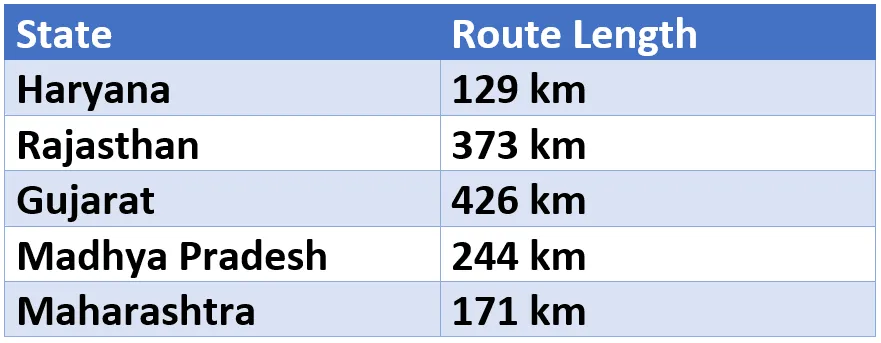Delhi Mumbai Expressway Route: A Game Changer for India’s Infrastructure
With the aim of linking two of India’s major economic hubs, the government has embarked on an ambitious project: the Delhi Mumbai Expressway. This 1,380-km controlled-access highway is set to revolutionize travel between Delhi and Mumbai, slashing travel time from 24 hours to just 12 hours. Launched in March 2019, the project is expected to be completed by December 2024.
The Vision Behind the Expressway
Reducing Travel Time
The primary goal of the Delhi Mumbai Expressway is to significantly reduce travel time between Delhi and Mumbai. Once completed, the expressway will cut the travel time in half, making it possible to drive from one city to the other in just 12 hours.
Economic Impact
The expressway will pass through five states and several greenfield sites, which will be developed into warehousing hubs. This will not only boost local economies but also create numerous job opportunities.
Key Features of the Expressway
Eight-Lane Highway
The expressway will feature eight lanes, ensuring smooth and efficient traffic flow. This will be India’s largest greenfield expressway, setting a new benchmark for infrastructure projects in the country.
E-Highway for Commercial Vehicles
To address vehicular pollution concerns, the government plans to build a separate e-highway on the Delhi Mumbai Expressway. This will allow commercial vehicles like trucks and buses to move at a speed of 120 kmph, reducing logistics costs by 70%.
Digital Highways
The National Highways Authority of India (NHAI) plans to develop the Delhi Mumbai Expressway, along with the Hyderabad-Bengaluru corridor, as digital highways. This will facilitate the faster rollout of technologies such as 5G networks.
Progress and Milestones
Inauguration of the First Stretch
On February 12, 2023, PM Narendra Modi inaugurated the first stretch of the expressway from Sohna in Haryana to Dausa in Rajasthan. This 246-km section will reduce travel time from Delhi to Jaipur to just three hours.
Latest Updates
On October 2, 2023, PM Modi inaugurated the new section from Delhi to Vadodara. This 845-km stretch will further enhance connectivity between the states, reducing travel time from 18-20 hours to just 10 hours.

Route Details
Section 1: DND-Faridabad-KMP Route (59 km)
The expressway will start from the Delhi Noida Driveway (DND) flyway in Delhi and pass through areas such as Shaheen Bagh, Okhla, and Kalindi Kunj. Sohna in Haryana will serve as an entry-exit point.
Section 2: Sohna-KMP-Vadodara (845 km)
This section will cover areas in Haryana, Rajasthan, Madhya Pradesh, and Gujarat. Key areas include Alipur Village, Sohna, and Nuh in Haryana, and Chhayan village, Godhra, and Vadodara in Gujarat.
Section 3: Vadodara-Virar (356 km)
This section will cover key areas such as Dodka Village, Fajapur Village, and Samiyala in Gujarat, and parts of Virar and Palghar in Maharashtra.
Section 4: Virar-JNPT (92 km)
In Maharashtra, the expressway will cover Virar, Amane, and Badlapur, finally ending at Jawaharlal Nehru Port Trust (JNPT) in Mumbai.
Sustainable Infrastructure
Wildlife Crossings
The expressway will feature India’s first animal bridges or overpasses, designed to keep wildlife unaffected by the new infrastructure. These will pass through the Ranthambore and Mukundra wildlife sanctuaries in Rajasthan.
Environment-Friendly Features
The expressway is expected to cut around 850 million kg of carbon dioxide emissions annually. It will also save about 32 crore liters of fuel every year. The lights on the expressway will operate on solar power, and there will be a tree cover of two million trees.
E-Highway
Four lanes on this eight-lane expressway will be dedicated to e-vehicles. A 1.5-metre-high wall will be constructed on both sides of the road for security, and toll plazas will be set up in slip lanes instead of highways.
Project Construction Phases
The expressway will be developed in four sections with a total of 52 construction packages. The approximate length of each package ranges from eight km to 46 km.
Timeline
- January 2019: Land acquisition for Haryana stretch completed.
- March 2019: Foundation stone laid.
- February 2020: Deadline postponed to January 26, 2023.
- February 12, 2023: Sohna-Dausa section becomes operational.
- September 2023: Madhya Pradesh section inaugurated.
- February 2024: Vadodara-Bharuch section inaugurated.
Cost and Funding
The Delhi Mumbai Expressway is being developed at a cost of around Rs 1,00,000 crores. The NHAI has set up a special purpose vehicle (SPV), DME Developers (DMEL), to finance the project. The SPV has raised Rs 9,731 crores to part-fund the project, with major contributions from the State Bank of India.
Toll Rates
The expressway will have over 90 exit points and the first-ever electric lane in India. The maximum toll amount for light vehicles (cars) is Rs 500, for commercial vehicles Rs 805, and for heavy vehicles (buses, trucks) Rs 1680.
Connectivity with Other Expressways
The Union Government plans to connect the Delhi Mumbai Expressway with the Agra-Gwalior greenfield expressway, the Bundelkhand expressway, and the Chennai-Surat expressway. This will significantly reduce travel time between various cities.
Real Estate Impact
The expressway is expected to significantly boost real estate opportunities along the corridor. Various townships, housing projects, and commercial properties are coming up in locations such as Gurgaon and Sohna.
Increase in Property Prices
The project has led to an increase in property prices, especially in Gurgaon and Sohna. Prominent developers are coming up with new projects along these locations.
New Real Estate Hubs
The expressway will pave the way for the development of new real estate hubs. Sohna near Gurgaon is emerging as a preferred real estate destination.
Conclusion
The Delhi Mumbai Expressway is set to be a game-changer for India’s infrastructure. By significantly reducing travel time and boosting economic growth, this project will have a lasting impact on the country’s development. With its focus on sustainability and technological advancements, the expressway is a testament to India’s commitment to building a better future.

